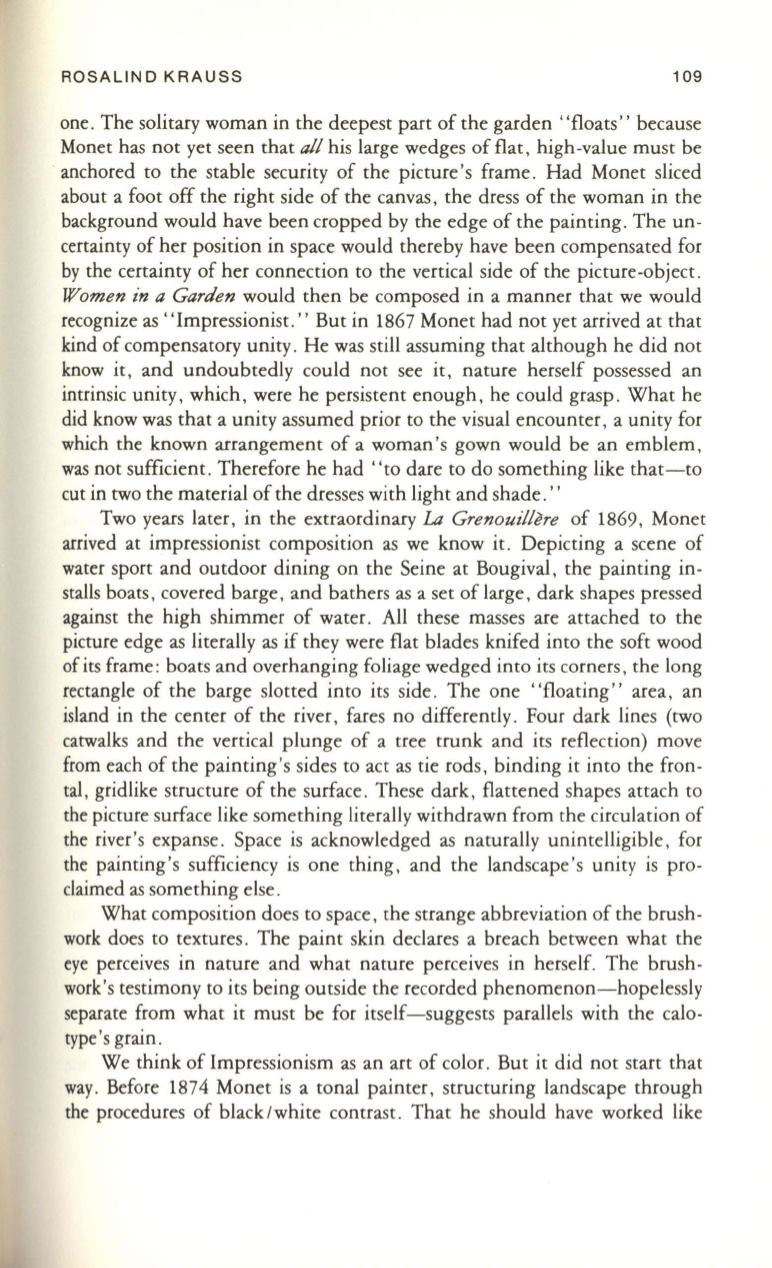
ROSALIND KRAUSS
109
one. The solitary woman in the deepest part of the garden "floats" because
Monet has not yet seen that
all
his large wedges of flat, high-value must be
anchored to the stable security of the picture's frame. Had Monet sliced
about a foot off the right side of the canvas, the dress of the woman in the
background would have been cropped by the edge of the painting. The un–
certainty of her position in space would thereby have been compensated for
by the certainty of her connection to the vertical side of the picture-object.
Women in a Garden
would then be composed in a manner that we would
recognize as "Impressionist." But in 1867 Monet had not yet arrived at that
kind of compensatory unity. He was still assuming that although he did not
know it, and undoubtedly could not see it, nature herself possessed an
intrinsic unity, which, were he persistent enough, he could grasp. What he
did know was that a unity assumed prior to the visual encounter, a unity for
which the known arrangement of a woman's gown would be an emblem,
was not sufficient. Therefore he had "to dare to do something like that-to
cut in two the material of the dresses with light and shade."
Two years later, in the extraordinary
La
GrenouzJlere
of 1869, Monet
arrived at impressionist composition as we know it. Depicting a scene of
water sport and outdoor dining on the Seine at Bougival, the painting in–
stalls boats, covered barge, and bathers as a set of large, dark shapes pressed
against the high shimmer of water. All these masses are attached to the
picture edge as literally as if they were flat blades knifed into the soft wood
of its frame: boats and overhanging foliage wedged into its corners, the long
rectangle of the barge slotted into its side. The one "floating" area, an
island in the center of the river, fares no differently. Four dark lines (two
catwalks and the vertical plunge of a tree trunk and its reflection) move
from each of the painting's sides to act as tie rods, binding it into the fron–
tal, gridlike structure of the surface . These dark, flattened shapes attach to
the picture surface like something literally withdrawn from the circulation of
the river's expanse. Space is acknowledged as naturally unintelligible , for
the painting's sufficiency is one thing, and the landscape's unity is pro–
claimed as something else.
What composition does to space, the strange abbreviation of the brush–
work does to textures. The paint skin declares a breach between what the
eye perceives in nature and what nature perceives in herself. The brush–
work's testimony to its being outside the recorded phenomenon-hopelessly
separate from what it must be for itself-suggests parallels with the calo–
type's grain.
We think of Impressionism as an art of color . But it did not start that
way . Before 1874 Monet is a tonal painter, structuring landscape through
the procedures of black/white contrast. That he should have worked like


